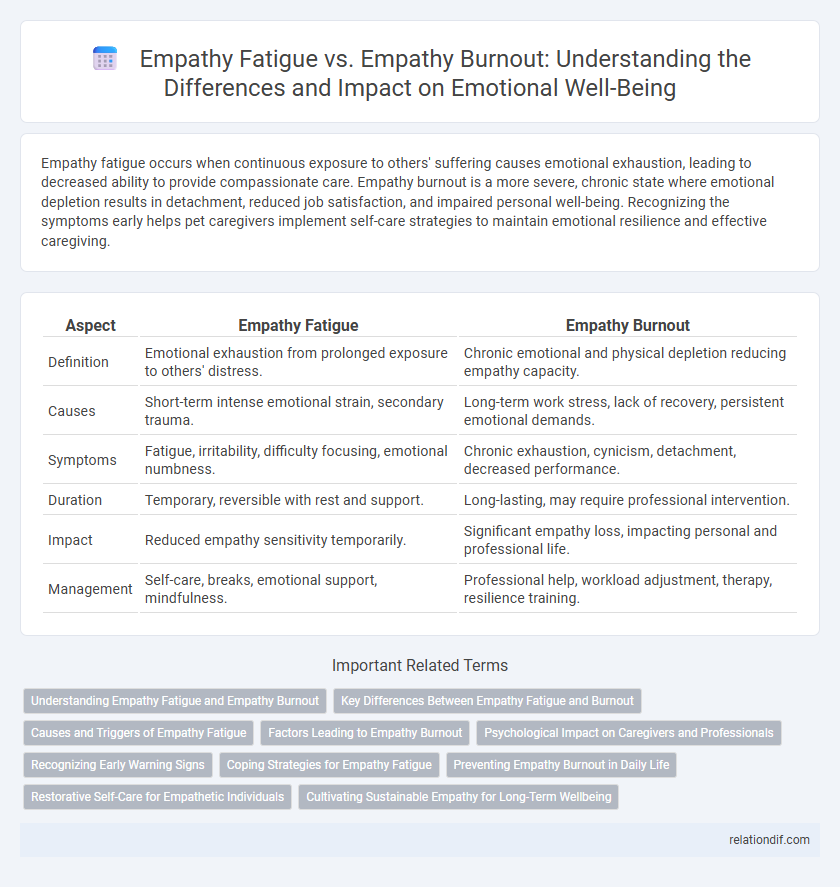Empathy fatigue occurs when continuous exposure to others' suffering causes emotional exhaustion, leading to decreased ability to provide compassionate care. Empathy burnout is a more severe, chronic state where emotional depletion results in detachment, reduced job satisfaction, and impaired personal well-being. Recognizing the symptoms early helps pet caregivers implement self-care strategies to maintain emotional resilience and effective caregiving.
Table of Comparison
| Aspect | Empathy Fatigue | Empathy Burnout |
|---|---|---|
| Definition | Emotional exhaustion from prolonged exposure to others' distress. | Chronic emotional and physical depletion reducing empathy capacity. |
| Causes | Short-term intense emotional strain, secondary trauma. | Long-term work stress, lack of recovery, persistent emotional demands. |
| Symptoms | Fatigue, irritability, difficulty focusing, emotional numbness. | Chronic exhaustion, cynicism, detachment, decreased performance. |
| Duration | Temporary, reversible with rest and support. | Long-lasting, may require professional intervention. |
| Impact | Reduced empathy sensitivity temporarily. | Significant empathy loss, impacting personal and professional life. |
| Management | Self-care, breaks, emotional support, mindfulness. | Professional help, workload adjustment, therapy, resilience training. |
Understanding Empathy Fatigue and Empathy Burnout
Empathy fatigue occurs when continuous exposure to others' emotional distress leads to temporary emotional exhaustion, reducing the ability to empathize effectively. Empathy burnout is a more severe, chronic condition characterized by deep emotional depletion, cynicism, and detachment, often requiring professional intervention for recovery. Understanding the differences between these states helps caregivers and professionals implement strategies to maintain emotional resilience and prevent long-term psychological harm.
Key Differences Between Empathy Fatigue and Burnout
Empathy fatigue, also known as compassion fatigue, primarily involves emotional exhaustion from constant exposure to others' suffering, leading to reduced capacity for empathy and temporary burnout-like symptoms. Burnout, while it may include empathy fatigue, is a broader syndrome characterized by chronic workplace stress resulting in physical, emotional, and mental depletion, decreased motivation, and reduced performance. Key differences lie in empathy fatigue's direct link to emotional strain from caregiving roles versus burnout's association with prolonged occupational stress and overall disengagement.
Causes and Triggers of Empathy Fatigue
Empathy fatigue primarily arises from prolonged exposure to others' trauma and suffering, leading to emotional exhaustion and reduced capacity for compassion. Common triggers include continuous caregiving roles, high-stress environments, and lack of adequate self-care or emotional support. Understanding these causes is essential for preventing empathy fatigue and maintaining mental well-being in caregiving professions.
Factors Leading to Empathy Burnout
Empathy burnout is primarily driven by prolonged emotional exhaustion, chronic exposure to others' trauma, and insufficient recovery time, which overwhelms an individual's capacity to cope. High-stress environments, such as healthcare or social work, amplify these factors, increasing vulnerability to empathy burnout more than occasional empathy fatigue. Recognizing early signs like depersonalization and reduced emotional responsiveness can help mitigate severe consequences of empathy burnout.
Psychological Impact on Caregivers and Professionals
Empathy fatigue and empathy burnout significantly affect caregivers and professionals by depleting emotional resources and reducing their capacity to connect with others. Empathy fatigue typically manifests as temporary emotional exhaustion from prolonged exposure to others' distress, while empathy burnout involves chronic psychological stress leading to diminished compassion and increased detachment. These conditions contribute to higher risks of depression, anxiety, and decreased job performance among healthcare workers and social service providers.
Recognizing Early Warning Signs
Recognizing early warning signs of empathy fatigue and empathy burnout is crucial for maintaining emotional well-being in caregiving roles. Symptoms often include persistent emotional exhaustion, reduced compassion, irritability, and detachment from others' feelings. Monitoring changes in sleep patterns, increased cynicism, and a decline in personal resilience can help identify these conditions before they escalate.
Coping Strategies for Empathy Fatigue
Empathy fatigue manifests as emotional exhaustion from continuous exposure to others' distress, whereas empathy burnout involves a deeper sense of detachment and reduced ability to empathize. Coping strategies for empathy fatigue include setting clear emotional boundaries, engaging in regular self-care activities like mindfulness and physical exercise, and seeking support through peer groups or professional counseling. Prioritizing restorative breaks and practicing reflective journaling enhances resilience and prevents progression to empathy burnout.
Preventing Empathy Burnout in Daily Life
Empathy burnout occurs when prolonged emotional strain depletes an individual's capacity to connect with others, often surpassing the effects of empathy fatigue, which is typically temporary and less severe. Preventing empathy burnout involves establishing firm boundaries, practicing regular self-care routines such as mindfulness and physical activity, and seeking professional support when needed. Cultivating emotional resilience through activities that enhance mental clarity and stress management can sustain empathetic engagement without compromising personal well-being.
Restorative Self-Care for Empathetic Individuals
Empathy fatigue manifests as emotional exhaustion from prolonged exposure to others' distress, while empathy burnout entails a deeper, chronic depletion of compassion leading to disengagement. Restorative self-care strategies such as mindfulness meditation, boundary setting, and regular emotional check-ins are essential for empathetic individuals to replenish emotional reserves. Incorporating activities like nature walks, creative expression, and professional counseling supports the recovery process and sustains long-term empathetic capacity.
Cultivating Sustainable Empathy for Long-Term Wellbeing
Empathy fatigue and empathy burnout differ in intensity and duration, with fatigue being temporary emotional exhaustion and burnout representing deeper, chronic depletion. Cultivating sustainable empathy involves balancing compassionate engagement with effective self-care strategies such as mindfulness, setting healthy boundaries, and periodic emotional detachment. Prioritizing these practices supports long-term wellbeing by preserving emotional resilience and preventing the deterioration of mental health in caregiving roles.
Empathy fatigue vs empathy burnout Infographic

 relationdif.com
relationdif.com